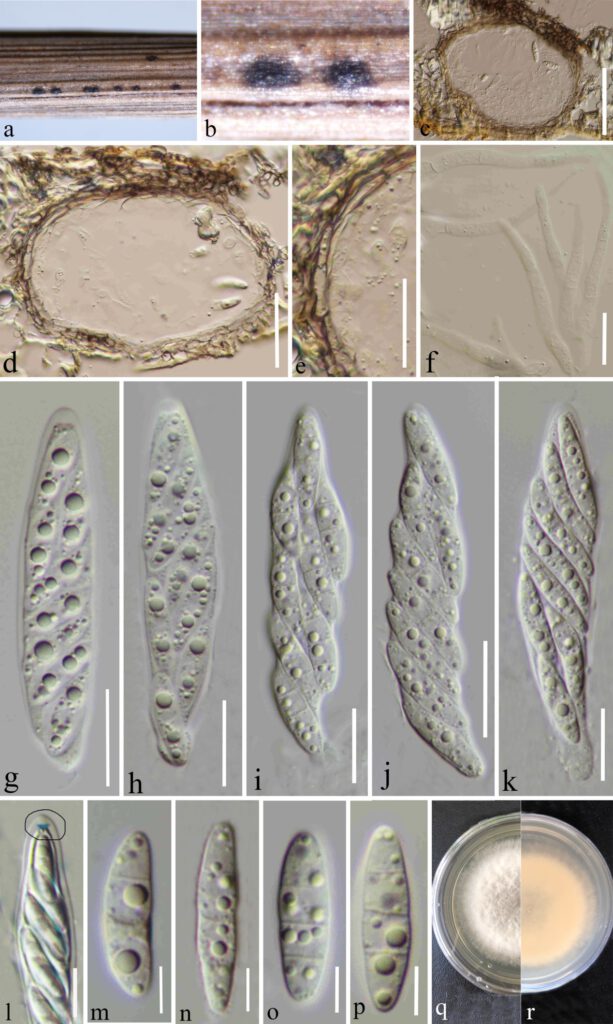Microdochium graminearum Y. Gao, H. Gui & K.D. Hyde, sp. nov.
MycoBank number: MB; Index Fungorum number: IF; Facesoffungi number: FoF 12703;
Etymology – The epithet refers to Gramineae.
Holotype – HKAS 123200
Appear as black spots on a dead herbaceous stem of grass, visible as black circular, or ellipsoid spots on host surface. Sexual morph: Ascomata 100–120 μm diam. × 70–90 μm high (x̅ = 105 × 78 μm, n = 12), scattered, gregarious, deeply immersed in host tissues, subglobose or elliptical, dark brown to black, uni-loculate, glabrous, without ostiolate. Peridium 5–15 μm thick, (x̅ = 9 μm, n = 20), composed of 2–3 layers of flattened, light brown to dark brown pseudoparenchymatous cells of textura angularis. Paraphyses 4–7 μm wide, (x̅ = 4.8 μm, n = 20), straight, septate, hyaline, unbranched, broader at the base, tapering towards the apex. Asci (55–)58–73(–77.6) × (9.6–)10.6–14.6(–15.5) μm (x̅ = 65.5 × 12.6 μm, SD =7.7 × 2 μm, n = 20), 8-spored, arising from base, fusiform, with a short pedicel, bitunicate, hyaline, with refractive ring around cytoplasmic protrusion, funnel-shaped apical ring. Ascospores (16.5–)18.4–22.5(–24) × (4–)4.1–5(–5.6) μm (x̅ = 20.4 × 4.6 μm, SD = 2 × 0.5 μm,n = 30), slightly overlapping, 1–2-seriate, hyaline, guttulate, lunate or allantoid to fusiform, with 0–3 transverse septa, often slightly constricted at medium septum, rounded to slightly pointed at both ends. Asexual morph: Undetermined.
Known host and distribution – herbaceous stem of grass (China).
Culture characteristics – Ascospores germinating on PDA within 20 hours at room temperature. Germ tube initially produced from the middle cell of ascospore. Colonies on PDA reaching 40 mm diameter after 4 weeks at 20–27 °C, circular, slightly raised, floccose, white from the above and yellowish from the below, smooth with filamentous edge, mycelium immersed in PDA and grows towards the edge.
Material examined – China, Yunnan Province, Kunming (25°8.19’N, 102°44.25’E), on decaying herbaceous stem of grass, 20 June 2021, Ying Gao (HKAS 123200, holotype), ex-type culture, CGMCC3.23525. ibid. (HKAS 123199, paratype), ex-paratype culture CGMCC3.23524.
Notes – Microdochium graminearum (HKAS 123200 and HKAS 123199) is introduced as a new species based on its distinct morphology and analysis of a combined LSU, ITS, tub2 and rpb2 dataset. Microdochium graminearum clusters close to Microdochium seminicola with 76 % ML bootstrap and 1.00 BYPP support (Fig. 1), a nucleotide pairwise comparison showed that Microdochium graminearum differs from Microdochium seminicola in 8/765 bp of tub2 (1.05 %) and 17/821 bp of rpb2 (2.07 %). Morphologically, the new species differs from Microdochium seminicola by its asci and ascospores characteristics. Asci of Microdochium graminearum are comparatively wider than M. seminicola (9.6–15.5 vs 7.5–11 μm). Microdochium graminearum has largely guttulated ascospores with a rough surface and M. seminicola has smooth-walled ascospores without or lacking guttules.

FIGURE 1 | Microdochium graminearum (HKAS 123200, holotype) (a,b) Appearance of immersed ascomata on the host; (c,d) Vertical section of the ascoma. (e) Peridium. (f) Paraphyses. (g–k) Asci. (l)Asci stained by melzer. (m–p) Ascospores. (q) Surface of colony on PDA. (r) Reverse of colony on PDA. Scale bars: (c) = 50 μm, (d) = 30 μm, (e,f) = 20 μm, (g–k) = 15 μm, (l)= 10 μm, (m–p) = 5 μm.
